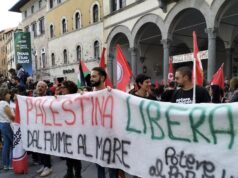By Soraia Arruda e Ramon Vesolon
This report was translated by the Angry Workers of the World from the original here.
On the 31st of March 2022, the miners of Companhia Siderúrgica Nacional went on strike in the mines at Casa de Pedra em Congonhas (MG) and Pieres em Ouro Preto (MG). They were going through collective agreement negotiations and the company was trying to impose a below inflation wage increase. In Usina Presidente Vargas em Volta Redonda (RJ), the steelworkers who work in maintenance scaffolding decided to stop working on April 5th and started to take action on their own terms. They were followed by the workers of the coal terminal ports and containers at the Port of Itaguaí, who also went on a strike.
A day before, a group of people that were summoned through social media, gathered workers from various sectors of the power plant in Volta Redonda. They were angry and wanted to go on strike. Hundreds of messages explained a generalised feeling within the factory: “We are fed up, tired of being slaves”. The proposal from the leaders of the group was to go on strike on Monday the 11th. However, tensions were high and the majority of workers did not want to wait. “I wouldn’t wait, we are tired of waiting and being betrayed by bought votes”. “We have been waiting three years, my friend, are we going to wait any longer?”
Some days before, the president of Vinchunha’s group, the main shareholder of CSN (Companhia Siderúrgica Nacional), Benjamin Steinbruch, announced profits of 13,6 billion reais in 2021. This is a record in the 80 years of the company, which came alongside the expansion of the empire with new businesses in various sectors. The workers’ wages, however, had not been readjusted for four years and had been melting away with the internal lag and inflation, which, as any worker knows, is rising much higher than official levels.
Benjamin became famous during the period of (neoliberal) restructuring under the PT government after giving an interview to Folha de São Paulo: “Brazil has changed, working conditions have changed and we have to adapt (…) The working day can be flexible, age can be flexible, work younger (…) For example, here we have a one-hour lunch break, normally we don’t need an hour for lunch. You go to the United States and you see a worker eating lunch with their left hand and operating the machine with their right.”
In the CSN magazine (the paper of Companhia Siderúrgica Nacional), there is an advertisement about the advantage of being “one of the lowest production costs in the world”. Inside the factory, people are working in precarious conditions. Salaries are among the lowest in the industry of this size in the country [2][3] and it is lower than that of local commerce and several other sectors that usually pay less.
The equation did not add up and the announcement of profits sounded like a mockery for those living in between deprivation and indebtedness. Between the outburst and agitation for the struggle, links to lending institutions circulated amongst the strike mobilisation group. A worker says a colleague’s son sleeps on a mat because he can’t afford a mattress now. It is not possible to spend a penny for more than the basics. Some have almost nothing to eat.
Under these conditions, the revolt spread through the factory and despite being aware of the risks of a wildcat strike in an extremely controlled space, someone said while joining the strike that morning: “the only fear I have is to continue with this precarious salary.’’
From “mother CSN” to a ‘’bloodsucking leech:” an empire of overexploitation
CSN was conceived as the “apple of the eye” of the national development process, with basically two functions: to be the driver of economic progress as a major producer of steel for the industrialisation and construction of the country’s infrastructure and to create a model for the domestication of workers through social welfare policies and union control.
The plan was to take the interests of both capital and workers into account, and enable a stable accumulation, without conflicts. It didn’t take long for this to prove impossible. The first generation of workers identified with the CSN, which invaded all dimensions of people’s lives, organising the city according to the company’s needs. Over time, this stable control and, mainly, the identification of workers with CSN was lost. Aiming only at production on a larger scale, management eliminated the prospect of social welfare. Younger workers detached themselves from the notion of “the steel family” and began to see themselves as “metal workers”.
The economic crisis of the 1980s triggered the first strike in the company’s history, which broke out in 1984 and was the rehearsal for another strike in 1988, one of the largest and most powerful in the country’s history. After the murder of three workers, CSN and the city of Volta Redonda became an immense battlefield where there were direct confrontations between the self-organised population and the repressive forces of the state for more than 20 days.
After the privatisation of the company, there was a wave of layoffs that changed the organisation of the company, putting an end to the paternalistic bond between the company and the workers. A model of savage capitalism was established. The aggressiveness of the managers took place on two levels: CSN stopped being a company focused only on the extraction of iron and steel production and expanded to other business lines such as logistics, cement and energy. [4]
On another front, it invested in the drastic expansion of the exploitation of workers.
“This businessman, Benjamin, bought CSN without paying a penny, he only started paying back after 30 years. The businessman is the biggest enslaver of manpower, he really enslaves the employees. Today there is no care. Today, money is in charge. We (employees) are just a registration. We have the lowest salary on the market, we have a food card that you can’t buy anything with, it’s been six, seven years since the company started to pay an allowance instead of paying a fair PLR (company’s result sharing). We have a terrible health plan, they took away the one from Bradesco, which was national. Our allowance is also different from supervisors and up, we were getting two thousand, three thousand reais, while an engineer, a supervisor was getting one hundred thousand, eighty thousand, you know? A pawn here earns less than the outsourced workers. A CSBI mechanic earns 2,400, here it is 1,640 reais. The company is useless, people die inside here. We don’t get paid for operating in risky environments. We get nothing but the loss of our health from the minimum wage, in a risk 4 company. [5] Before the strike, a retired worker lost his hand here, it was not reported in the newspaper. The company does not invest, it is a scumbag”.
Another worker says: “We are working for two, doubling every day, there are people there who work on their days off… The situation is so extreme that some people even consider the possibility of dismissal as a release from this slavery.”
Union? What’s the point of a union?
This arrangement of intensive exploitation, at the same time that it boosts accumulation, creates a gap in people’s lives…at some point, the rope breaks. The union, after a long history of acting in favour of the company no longer has the confidence of workers (in addition to the fraudulent agreements they approved that lowered working conditions year after year, in 2017 they sold off the 6-hour shift that was won in the 1988 strike). “For many years Silvão & Cia have been in “Judas” mode, selling the gang for 30 silver coins”.
The union [6], alien to the workers’ movement, was taken by surprise as they prepared for the next elections and started the dispute over the direction of the movement. When they saw the tram moving, they tried to brake. For them, it was necessary to wait, comply with the institutional protocol and follow their instructions. One of the union leaders said:
“There is the right way to resolve the situation. The Opposition Metalúrgica do Sul Fluminense, the true metallurgical opposition, is alongside the workers in this fight and understands that the guidelines that are being followed regarding the stoppage on the 11th, these guidelines approved by a group of people using the name of the metallurgical opposition, are suicide. It’s a wrong policy and there is a right way to do it within the law. We, the true opposition from the Sul Fluminense, have the path to resolve this within the law…”
After this speech, a worker responded:
“You just have to warn that gentleman there who talked about persecution. That persecution we (the workers) suffer every day. You have to stop talking and go and speak to the workers. Stop talking nice and support the workers, do not let anything happen to them, because everyone is fighting for their rights. No one is making a ruckus here, everyone works, gives their blood, how many people have already lost their lives in here, and that’s it? Don’t use our family, our difficulty to put us to work, no, stop talking nice and be honest.”
Following this line of despising what escapes the group’s control, the opposition continued to try to push back the self-organised movement. After almost three decades of demobilisation and passiveness of the workers’ movement in the country, some experiences began to get out of control and tried to lose the fear that binds us and makes us accept a life that is not life. In the face of this, they (the unions) try to put out the fire and save order, just as the left has done in general; they try to restore the expectations in crisis to save the institutions. They do this because they need to maintain the bases they want to manage and, out of an instinct of self-preservation, they would never put their structures at risk to take the movement as far as the workers want to.
But following the comments of these “prophets of the past”(union), the fury of those who no longer had anything to lose, and workers who were willing to take the risk, appeared. The awareness that, “no one will do for us what we need to do” led the maintenance scaffolding workers to take things into their own hands. They ran over those who advocated “waiting for the right time and doing things the right way”. “There is no right time, it is time for us to get together”.
‘Ohhh… The peon is back, the peon is back…’ – (Chant of workers, challenging the fact that they are normally seen as the bottom of the pile)
“A week before the wildcat strike, the GMR [Gerência de Manutenção – general maintenance department] had organised a strike over working conditions. The following week a group was formed. No one knew how the group took shape, only that lots of workers joined the movement. That is when we requested the strike. That was on a Sunday. On Monday, the maintenance scaffolding workers had decided to stop working following two months of talks. When the GMR took part in a strike, they did not know so they did not show support. Then the maintenance scaffolding workers stopped, but the bosses decided to put pressure and force them to go back to work. The workers did not give in and they decided to walk to the SOM [Superintendência de Oficinas Mecânicas] during lunch, to strike there. But they didn’t give in and when it was lunch time they walked to SOM [Superintendence of Mechanical Workshops], to stop there. When they got there, other areas had seen in the group that they had stopped in their area and were already there at Som stopped too. Some other areas like the GMC [Gerência de Manutenção Central – Central maintenance department], the GMR, already had a staff stopped. GMN, which are management [7] there. The maintenance scaffolding workers came walking, a supervisor said he was going to order a bus for them to have lunch there at SOM. They said, no, we’re going to walk. And when they came on foot, they came calling the crowd, ‘or, let’s stop, let’s stop!’ and the crowd left the area, abandoned the service and went to stop. That Monday went relatively well, more workers joined on Tuesday and Wednesday was a success. That is when the company begun to feel the consequences of the strike.”
Since then, workers entered the factory and gathered in the SOM maintenance yard. Meetings were held to define agreements and the next steps of the movement. A negotiation committee was elected to present the workers’ proposal: 30% wage increase, 10% of total profit as PLR Profit Sharing and not as a bonus and equal value for all functions, a national healthcare plan, monthly overtime pay and 800 reais in food vouchers. Thousands marched through the city chanting, “Oooh, the peon is back, the peon is back”… The following day there was a negotiation round and the company’s proposal was voted on. This time it took place in Juarez Antunes Square, a place chosen by the workers, not inside the company as the union usually does to rig the result. With shouts of, “the steal is over!” The votes were counted with the result of 6,040 people saying no to the agreement and 39 voting yes.
With the immense demonstration of strength and mobilisation capacity in these first days of the strike, the company began to play hardball to prevent those who had not taken part in the strike from joining, and to put pressure on those who had. It reinforced the pressure and intimidation of area supervisors. The company bought the workers who scabbed mattresses to sleep on inside the factory, so they didn’t run the risk of being barred entry the next day if there were pickets outside. The company also sent lunchboxes to some departments so that workers would not move around the plant and come into contact with the movement. And then they started to fire workers. They fired the entire trading commission. In all, around 400 people have been laid off so far. The effects of this were demobilising and people went back to work.
Despite this, the sacked commission is still active, trying to get peoples’ jobs back and helping with the mobilisation inside the factory. The tension remains strong. This Friday (22/04), the company presented a new proposal, as miserable as the previous ones and the climate is one of rejection. Several workers at that moment signalled the decision to resume the strike and discuss the expansion of the mobilisation.
We don’t know the outcome of this mobilisation yet. The company is trying to beat the tired workers alongside the union that pretends to ‘’guide’’ the workers on making their demands while the company pretends it is giving in on something. The intention is to take advantage of the tight situation and workers’ indebtedness to push for another bad deal. But above all, it seeks to demoralise the movement and the autonomous force that the workers have shown it is possible to create.
If there is something worth fighting for in these times of immense difficulty, it is for the courage and rebelliousness of those who are tired of waiting for someone to save or solve what we can only do ourselves. The experiences of workers’ autonomous mobilisations have grown in recent times. A few weeks ago, there were the street sweepers in Rio de Janeiro and app-based and transport workers have frequently led their own struggles. This is in a context in which strikes in general have been expanding. Articulating these experiences and looking for ways to deepen their anti-systemic aspects can be a light at the end of the tunnel. Rebellion, solidarity between strikers and control of work itself, which confront fundamental elements for the reproduction of capital such as passivity, competition and domination are some of them.






